Sholto David broke all the rules. You see, when you write about research fraud, especially on a scale of a papermill, it is supposed to happen somewhere in Asia. Never in USA. Never in the most prestigious American universities and medical institutions. And even if some foreigners do commit massive fraud, it certainly can’t involve white elites of US cancer research like M Celeste Simon. Yet here were are.
But the main character of this story is the Columbia University’s surgeon Sam S Yoon. And his magic postdoc, also named Yoon.
A Visit from the Yoon Squad: PaperMill at Memorial Sloan Kettering
By Sholto David
Please allow me to introduce the work of Dr. Sam S. Yoon, who spent the last decade (2012 to 2021) publishing his seminal research at Memorial Sloan Kettering Cancer Center (probably the second-best cancer hospital in the world according to most listings). Sam graduated from Harvard University and received his medical degree from University of California at San Diego. He has also worked as an associate professor of surgery at Harvard Medical School, and is currently at Columbia University, where he is now chief of the division of surgical oncology. In fact, this blog will be a whistle-stop tour of elite institutions and cancer centres around the US.

Starting back in 2008 when Sam was at Harvard Medical School, a fairly innocuous example of image duplication, which by itself, does not earn a blog post… although it is notable that seven employees of Harvard Medical School did not identify this error.
Namali T. Fernando, Moritz Koch, Courtney Rothrock, Lila K. Gollogly, Patricia A. D’Amore, Sandra Ryeom, Sam S. Yoon Tumor Escape from Endogenous, Extracellular Matrix–Associated Angiogenesis Inhibitors by Up-Regulation of Multiple Proangiogenic Factors Clinical Cancer Research (2008) doi: 10.1158/1078-0432.ccr-07-4126
Moving on to a pair of duplication errors in a 2010 paper with researchers from Harvard Medical School, UCLA, and Penn Medicine. Authored together with M. Luisa Iruela-Arispe (then at UCLA and now a department chair at Northwestern University Feinberg School of Medicine), and Daniel Karl (then at Harvard Medical School and now an associate director at AstraZeneca). Let’s hope everyone improved their spot-the-difference skills as their careers advanced!
Yoon-Jin Lee, Moritz Koch, Daniel Karl, Antoni X. Torres-Collado, Namali T. Fernando, Courtney Rothrock, Darshini Kuruppu, Sandra Ryeom, M. Luisa Iruela-Arispe, Sam S. Yoon Variable Inhibition of Thrombospondin 1 against Liver and Lung Metastases through Differential Activation of Metalloproteinase ADAMTS1 Cancer Research (2010) doi: 10.1158/0008-5472.can-09-3094


Soon after his stint at Memorial Sloan Kettering started, the following figure was put together by Sam and his colleagues, including Jeffrey A Toretsky at Georgetown university (now Chief of the Division of Pediatric Hematology) and David Guy Kirsch at Duke University (now a Distinguished Professor there).
Hae-June Lee, Changhwan Yoon, Benjamin Schmidt, Do Joong Park, Alexia Y. Zhang, Hayriye V. Erkizan, Jeffrey A. Toretsky, David G. Kirsch, Sam S. Yoon Combining PARP-1 Inhibition and Radiation in Ewing Sarcoma Results in Lethal DNA Damage Molecular Cancer Therapeutics (2013) doi: 10.1158/1535-7163.mct-13-0338
As far as I am concerned, these above examples are relatively minor infractions, but it is still puzzling that such muddles are possible with so many big brains on the team. But the trouble really started when a certain Changhwan Yoon migrated to Sam’s lab from South Korea in around 2014 (I don’t think he is any relation to Sam S. Yoon, but I may be mistaken). Changhwan Yoon is currently the only member of the Yoon lab, and you will now see why he is more productive than a few dozen regular postdocs.

At this point a series of papers including migration and invasion assays began to be published which would make even a traditional Chinese papermill sweat…
- Changhwan Yoon, Do Joong Park, Benjamin Schmidt, Nicholas J Thomas, Hae-June Lee, Teresa S Kim, Yelena Y Janjigian, Deirdre J Cohen, S. S. Yoon CD44 expression denotes a subpopulation of gastric cancer cells in which Hedgehog signaling promotes chemotherapy resistance Clinical Cancer Research (2014) doi: 10.1158/1078-0432.ccr-14-0011
- Kevin K. Chang, Changhwan Yoon, Brendan C. Yi, William D. Tap, M. Celeste Simon, Sam S. Yoon Platelet-derived growth factor receptor-α and -β promote cancer stem cell phenotypes in sarcomas Oncogenesis (2018) doi: 10.1038/s41389-018-0059-1
- Y Suh, C-H Yoon, R-K Kim, E-J Lim, Y S Oh, S-G Hwang, S An, G Yoon, M C Gye, J-M Yi, M-J Kim, S-J Lee Claudin-1 induces epithelial-mesenchymal transition through activation of the c-Abl-ERK signaling pathway in human liver cells Oncogene (2013) doi: 10.1038/onc.2012.505

The above three papers include distinguished researchers such as Deirdre J. Cohen (currently Director of the Gastrointestinal Oncology Program for the Mount Sinai Health System), Yelena Y. Janjigian (now Chief of the Gastrointestinal Oncology Service at Memorial Sloan Kettering), and M. Celeste Simon (Scientific Director of The Abramson Family Cancer Research Institute, University of Pennsylvania Perelman School of Medicine) – we will hear more from M. Celeste Simon later, but first more migration and invasion assay difficulties:
- Changhwan Yoon, Soo-Jeong Cho, Bülent Arman Aksoy, Do Joong Park, Nikolaus Schultz, Sandra W. Ryeom, Sam S. Yoon Chemotherapy Resistance in Diffuse-Type Gastric Adenocarcinoma Is Mediated by RhoA Activation in Cancer Stem-Like Cells Clinical Cancer Research (2016) doi: 10.1158/1078-0432.ccr-15-1356
- Jian-xian Lin, Changhwan Yoon, Ping Li, Sandra W. Ryeom, Soo-Jeong Cho, Chao-hui Zheng, Jian-wei Xie, Jian-bin Wang, Jun Lu, Qi-yue Chen, Sam S. Yoon, Chang-ming Huang CDK5RAP3 as tumour suppressor negatively regulates self-renewal and invasion and is regulated by ERK1/2 signalling in human gastric cancer British Journal of Cancer (2020) doi: 10.1038/s41416-020-0963-y
- Soo-Jeong, Changhwan Yoon, Jun Ho Lee, Kevin K. Chang, Jian-xian Lin, Young-Ho Kim, Myeong-Cherl Kook, Bülent Arman Aksoy, Do Joong Park, Hassan Ashktorab, Duane T. Smoot, Nikolaus Schultz, Sam S. Yoon KMT2C Mutations in Diffuse-Type Gastric Adenocarcinoma Promote Epithelial-to-Mesenchymal Transition Clinical Cancer Research (2018) doi: 10.1158/1078-0432.ccr-17-1679

With the above three papers including (among others) co-authors from China (Chang-Ming Huang; Director of Department of Gastric Surgery, Fujian Medical University Union Hospital, China), and Korea (Do Joong Park and Soo Jeong Cho; both associate professors at Seoul National University). Hassan Ashktorab (currently Professor in the Department of Medicine at Howard University) and Duane T. Smoot (now Chair and Professor at the Department of Internal Medicine at Meharry Medical College). Another troublesome example follows:
- Changhwan Yoon, Jacob Till, Soo-Jeong Cho, Kevin K. Chang, Jian-xian Lin, Chang-ming Huang, Sandra Ryeom, Sam S. Yoon KRAS Activation in Gastric Adenocarcinoma Stimulates Epithelial-to-Mesenchymal Transition to Cancer Stem–Like Cells and Promotes Metastasis Molecular Cancer Research (2019) doi: 10.1158/1541-7786.mcr-19-0077
- Jun Lu, Heejin Bang, Su Mi Kim, Soo-Jeong Cho, Hassan Ashktorab, Duane T. Smoot, Chao-hui Zheng, Sandra W. Ryeom, Sam S. Yoon, Changhwan Yoon, Jun Ho Lee Lymphatic metastasis-related TBL1XR1 enhances stemness and metastasis in gastric cancer stem-like cells by activating ERK1/2-SOX2 signaling Oncogene (2021) doi: 10.1038/s41388-020-01571-x
And a final example of these images migrating between papers, with many of the same co-accused, including Sandra W. Ryeom, who is closely associated with Sam’s research and currently Associate Professor and Associate Dean for Postdoctoral Affairs at Columbia University.
- Changhwan, Jun Lu, Sandra W. Ryeom, M. Celeste Simon, Sam S. Yoon PIK3R3, part of the regulatory domain of PI3K, is upregulated in sarcoma stem-like cells and promotes invasion, migration, and chemotherapy resistance Cell Death and Disease (2021) doi: 10.1038/s41419-021-04036-5
- Sang Il Choi, Changhwan Yoon, Mi Ree Park, DaHyung Lee, Myeong-Cherl Kook, Jian-Xian Lin, Jun Hyuk Kang, Hassan Ashktorab, Duane T. Smoot, Sam S. Yoon, Soo-Jeong Cho CDX1 Expression Induced by CagA-Expressing Helicobacter pylori Promotes Gastric Tumorigenesis Molecular Cancer Research (2019) doi: 10.1158/1541-7786.mcr-19-0181
- Kevin K. Chang, Changhwan Yoon, Brendan C. Yi, William D. Tap, M. Celeste Simon, Sam S. Yoon Platelet-derived growth factor receptor-α and -β promote cancer stem cell phenotypes in sarcomas Oncogenesis (2018) doi: 10.1038/s41389-018-0059-1
In total, I have found ten papers published between 2013 and 2021 where these invasion and migration images appear and are labelled as showing a variety of contradicting cell lines and experimental conditions, there are many more overlapping examples between these papers that I have not annotated. The first paper in this series was published by a team of Korean authors in Oncogene (Sam was not an involved), and the images presumably made their way to America with one of the authors of that paper, Changhwan (or C-H) Yoon.
Y Suh, C-H Yoon, R-K Kim, E-J Lim, Y S Oh, S-G Hwang, S An, G Yoon, M C Gye, J-M Yi, M-J Kim, S-J Lee Claudin-1 induces epithelial-mesenchymal transition through activation of the c-Abl-ERK signaling pathway in human liver cells Oncogene (2013) doi: 10.1038/onc.2012.505
Interestingly, this first paper was subject to a correction in 2016 after a duplicated western blot was detected, this was noted on PubPeer as part of a project to screen 120 randomly selected papers for data duplication, this screening exercise was later published (Oksvold 2015). Neither the original author of the PubPeer comment, the journal editors, or any of the authors who corrected the article noticed the additional duplications in the invasion images. I think most of the blame lies with the editor and publisher in this case: If an article is flagged for duplications, why not request and check all of the raw data?
In any case, it isn’t clear to me why (in 2021) authors are still adding low resolution black and white images like these to their papers? A lot of this seems to be stocking-filler data, added to flesh out a paper which was written to flesh out a publication record. But we should move on! Obviously no one looks at these images anyway, certainly not the editors, reviews, least of all the authors.
Cell Death and Depravity
Is the journal Cell Death and Disease a disease itself, parasitised by Chinese paper mills? Can it be cured? Not with this team of doctors on editorial board.
There are further troubled microscopy projects to explore. In just one paper, published in Nature’s odious tome Cell Death and Disease, apart from the ubiquitous invasion and migration problems detailed above, the following examples of duplication can be found:
Changhwan Yoon, Jun Lu, Sandra W. Ryeom, M. Celeste Simon, Sam S. Yoon PIK3R3, part of the regulatory domain of PI3K, is upregulated in sarcoma stem-like cells and promotes invasion, migration, and chemotherapy resistance Cell Death and Disease (2021) doi: 10.1038/s41419-021-04036-5
Jian-xian Lin, Changhwan Yoon, Ping Li, Sandra W. Ryeom, Soo-Jeong Cho, Chao-hui Zheng, Jian-wei Xie, Jian-bin Wang, Jun Lu, Qi-yue Chen, Sam S. Yoon, Chang-ming Huang CDK5RAP3 as tumour suppressor negatively regulates self-renewal and invasion and is regulated by ERK1/2 signalling in human gastric cancer
British Journal of Cancer (2020) doi: 10.1038/s41416-020-0963-y
Chuang Huang, Changhwan Yoon, Xiao-Hong Zhou, Ying-Chun Zhou, Wen-Wen Zhou, Hong Liu, Xin Yang, Jun Lu, Sei Young Lee, Kun Huang ERK1/2-Nanog signaling pathway enhances CD44(+) cancer stem-like cell phenotypes and epithelial-to-mesenchymal transition in head and neck squamous cell carcinomas Cell Death and Disease (2020)
doi: 10.1038/s41419-020-2448-6
Kevin K. Chang, Changhwan Yoon, Brendan C. Yi, William D. Tap, M. Celeste Simon, Sam S. Yoon Platelet-derived growth factor receptor-α and -β promote cancer stem cell phenotypes in sarcomas Oncogenesis (2018)
doi: 10.1038/s41389-018-0059-1
Confusing different cell types is a common theme in Sam’s research, here for example SNU-688 spheroids are confused with SCC-15 spheroids.
- Changhwan Yoon, Soo-Jeong Cho, Bülent Arman Aksoy, Do Joong Park, Nikolaus Schultz, Sandra W. Ryeom, Sam S. Yoon Chemotherapy Resistance in Diffuse-Type Gastric Adenocarcinoma Is Mediated by RhoA Activation in Cancer Stem-Like Cells Clinical Cancer Research (2016) doi: 10.1158/1078-0432.ccr-15-1356
- Chuang Huang, Changhwan Yoon, Xiao-Hong Zhou, Ying-Chun Zhou, Wen-Wen Zhou, Hong Liu, Xin Yang, Jun Lu, Sei Young Lee, Kun Huang ERK1/2-Nanog signaling pathway enhances CD44(+) cancer stem-like cell phenotypes and epithelial-to-mesenchymal transition in head and neck squamous cell carcinomas Cell Death and Disease (2020) doi: 10.1038/s41419-020-2448-6
In the following example the cell lines match, but the treatment conditions are different:
- Changhwan Yoon, Jacob Till, Soo-Jeong Cho, Kevin K. Chang, Jian-xian Lin, Chang-ming Huang, Sandra Ryeom, Sam S. Yoon KRAS Activation in Gastric Adenocarcinoma Stimulates Epithelial-to-Mesenchymal Transition to Cancer Stem–Like Cells and Promotes Metastasis Molecular Cancer Research (2019) doi: 10.1158/1541-7786.mcr-19-0077
- Jun Lu, Heejin Bang, Su Mi Kim, Soo-Jeong Cho, Hassan Ashktorab, Duane T. Smoot, Chao-hui Zheng, Sandra W. Ryeom, Sam S. Yoon, Changhwan Yoon, Jun Ho Lee Lymphatic metastasis-related TBL1XR1 enhances stemness and metastasis in gastric cancer stem-like cells by activating ERK1/2-SOX2 signaling Oncogene (2021) doi: 10.1038/s41388-020-01571-x
Another common confusion is between xenograft tumor images. For example, in the following paper there is at least one image overlapping between Figure 4D and Figure 6D.
Changhwan Yoon, Jun Lu, Brendan C. Yi, Kevin K. Chang, M. Celeste Simon, Sandra Ryeom, Sam S. Yoon PI3K/Akt pathway and Nanog maintain cancer stem cells in sarcomas Oncogenesis (2021) doi: 10.1038/s41389-020-00300-z
The following two figures include an overlap between papers (red rectangles) and an additional overlap within one of the papers (green rectangles). The intensity of the blue colour is different between these images.
- Jun Lu, Heejin Bang, Su Mi Kim, Soo-Jeong Cho, Hassan Ashktorab, Duane T. Smoot, Chao-hui Zheng, Sandra W. Ryeom, Sam S. Yoon, Changhwan Yoon, Jun Ho Lee Lymphatic metastasis-related TBL1XR1 enhances stemness and metastasis in gastric cancer stem-like cells by activating ERK1/2-SOX2 signaling Oncogene (2021) doi: 10.1038/s41388-020-01571-x
- Kevin K. Chang, Changhwan Yoon, Brendan C. Yi, William D. Tap, M. Celeste Simon, Sam S. Yoon Platelet-derived growth factor receptor-α and -β promote cancer stem cell phenotypes in sarcomas Oncogenesis (2018) doi: 10.1038/s41389-018-0059-1
Another example of an overlapping tumor xenograft, this time with slightly different intensity in the green channel, but certainly an image of the same tumor. Apart from being given cancer, the mice were also blasted with a dose of radiation here for their sins, this being the second of Sam’s two papers in Cell Death and Depravity.
Chuang Huang, Changhwan Yoon, Xiao-Hong Zhou, Ying-Chun Zhou, Wen-Wen Zhou, Hong Liu, Xin Yang, Jun Lu, Sei Young Lee, Kun Huang ERK1/2-Nanog signaling pathway enhances CD44(+) cancer stem-like cell phenotypes and epithelial-to-mesenchymal transition in head and neck squamous cell carcinomas Cell Death and Disease (2020) doi: 10.1038/s41419-020-2448-6

Another example of recycled images with contradicting labels is shown below, including Edwin Choy (Associate Professor at Harvard), who is a frequent co-author with Francis J. Hornicek and Zhenfeng Duan who I previously wrote about.
Miami Vice: Francis Hornicek & Zhenfeng Duan
Sholto David brings you a new true crime story. This time featuring two twisted orthopaedics professors from the University of Miami! Will they end up in Sholto’s science jail for their fake cancer research? The perpetrators, Francis J. Hornicek and Zhenfeng Duan, already received a deserved yet somewhat botched retraction at SAGE Publishers, where the…
Also included as an author is Charles P. Hart, who at the time was an employee of Threshold Pharmaceuticals and worked as the “project leader for the global clinical development program for the hypoxia-targeted anticancer drug evofosfamide (TH-302)”. Given the title of the second paper (“Hypoxia-activated chemotherapeutic TH-302 enhances the effects of VEGF-A inhibition and radiation on sarcomas“) you might think a conflict-of-interest statement would have been useful, but you would be wrong, the British Journal of Cancer has no space for such information in the ancient history of 2016. You are free to rustle up some positive spin for your developmental drug with some cooked images and you must be spared the embarrassment of any unseemly appearance of bias.
- Changhwan Yoon, Kevin K. Chang, Jun Ho Lee , William D. Tap, Charles P. Hart, M. Celeste Simon, Sam S. Yoon Multimodal targeting of tumor vasculature and cancer stem-like cells in sarcomas with VEGF-A inhibition, HIF-1α inhibition, and hypoxia-activated chemotherapy Oncotarget (2016) doi: 10.18632/oncotarget.10212
- C Yoon, H-J Lee, D J Park, Y-J Lee, W D Tap, T S K Eisinger-Mathason, C P Hart, E Choy, M C Simon, S S Yoon Hypoxia-activated chemotherapeutic TH-302 enhances the effects of VEGF-A inhibition and radiation on sarcomas British Journal of Cancer (2015) doi: 10.1038/bjc.2015.186

Another example of xenograft mislabelling, this time the authors finally found the rotate tool and changed the colour hue, which is still no match for ImageTwin.ai. Although these are control images, the mouse model in each case is different, so the image reuse is not acceptable.
Hae-June Lee, Changhwan Yoon, Do Joong Park, Yeo-Jung Kim, Benjamin Schmidt, Yoon-Jin Lee, William D. Tap, T.S. Karin Eisinger-Mathason, Edwin Choy, David G. Kirsch, M. Celeste Simon, Sam S. Yoon Inhibition of Vascular Endothelial Growth Factor A and Hypoxia-Inducible Factor 1α Maximizes the Effects of Radiation in Sarcoma Mouse Models Through Destruction of Tumor Vasculature International Journal of Radiation Oncology*Biology*Physics (2015) doi: 10.1016/j.ijrobp.2014.10.047
One last example in the theme of tumour xenografts, and this is in fact the image which sent me spiralling down this rabbit hole (Having set a target to check the last five years of BMC Cancer, I made it through only their 14 most recent research papers, left three comments, and then became diverted by this paper):
Changhwan Yoon, Jun Lu, Yukyung Jun, Yun-Suhk Suh, Bang-Jin Kim, Jacob E. Till, Jong Hyun Kim, Sara H. Keshavjee, Sandra Ryeom, Sam S. Yoon KRAS activation in gastric cancer stem-like cells promotes tumor angiogenesis and metastasis BMC Cancer (2023) doi: 10.1186/s12885-023-11170-0
Whilst looking through the author list here, I found one current medical student, which I think is a little sad, possibly their first publication, tainted by this careless behaviour before even graduating! But of course, it isn’t as sad as what happened to the mice! Not only are microscopic images of tumours muddled, but macroscopic too…
- Changhwan Yoon, Soo-Jeong Cho, Kevin K. Chang, Do Joong Park, Sandra W. Ryeom, Sam S. Yoon Role of Rac1 Pathway in Epithelial-to-Mesenchymal Transition and Cancer Stem-like Cell Phenotypes in Gastric Adenocarcinoma Molecular Cancer Research (2017) doi: 10.1158/1541-7786.mcr-17-0053
- Changhwan Yoon, Jun Lu, Brendan C. Yi, Kevin K. Chang, M. Celeste Simon, Sandra Ryeom, Sam S. Yoon PI3K/Akt pathway and Nanog maintain cancer stem cells in sarcomas Oncogenesis (2021) doi: 10.1038/s41389-020-00300-z
In this case one of the tumour images is only available in black and white because it was published (thousands of years ago) in 2016, fortunately the colour camera was working by 2021, so the same photo could be published after the ruler was moved.
- Changhwan Yoon, Jun Lu, Brendan C. Yi, Kevin K. Chang, M. Celeste Simon, Sandra Ryeom, Sam S. Yoon PI3K/Akt pathway and Nanog maintain cancer stem cells in sarcomas Oncogenesis (2021) doi: 10.1038/s41389-020-00300-z
- Changhwan Yoon, Soo-Jeong Cho, Bülent Arman Aksoy, Do Joong Park, Nikolaus Schultz, Sandra W. Ryeom, Sam S. Yoon Chemotherapy Resistance in Diffuse-Type Gastric Adenocarcinoma Is Mediated by RhoA Activation in Cancer Stem-Like Cells Clinical Cancer Research (2016) doi: 10.1158/1078-0432.ccr-15-1356
And finally in the following example I can confirm that the last author has admitted an error, but not without putting up a fight. Sam is only a co-author on the PNAS paper below, so the blame here can’t be laid entirely at his feet (I’m sure he has enough to answer for already).
- T. S. Karin Eisinger-Mathason, Vera Mucaj, Kevin M. Biju, Michael S. Nakazawa, Mercy Gohil, Timothy P. Cash, Sam S. Yoon, Nicolas Skuli, Kyung Min Park, Sharon Gerecht, M. Celeste Simon Deregulation of the Hippo pathway in soft-tissue sarcoma promotes FOXM1 expression and tumorigenesis Proceedings of the National Academy of Sciences (2015) doi: 10.1073/pnas.1420005112
- Michael S. Nakazawa, T. S. Karin Eisinger-Mathason, Navid Sadri, Joshua D. Ochocki, Terence P. F. Gade, Ruchi K. Amin, M. Celeste Simon Epigenetic re-expression of HIF-2α suppresses soft tissue sarcoma growth Nature Communications (2016) doi: 10.1038/ncomms10539
M. Celeste Simon is the last author on both of the above papers and a frequent co-author of Sam S. Yoon’s. As usual I have begun the fool’s errand of contacting universities regarding this swamp of misconduct. Simon was first out of the block with a response and her defence is a stupid one:
“I cannot comment on the work performed in another individual’s laboratory where we provided reagents, but the “duplications” you cite in our Nature Communications and PNAS papers were intended to be images from the same cohort of control mice for a number of other gene targeted animals.“
M. Celeste Simon
After further communication the esteemed Scientific Director, Investigator and Arthur H. Rubenstein MBBCh Professor agreed that two identical pictures of a mouse tumor can’t show different experiments and promised to correct the Nature Communications paper. No further explanation as to why she thinks it’s OK to add her name as the last and corresponding author to research if she merely “supplied reagents”.
Pound of Flesh, or Is Cancer Fraud Inevitable?
Ashani Weeraratna and Valerie Weaver, two women in STEM, harassed by trolls.
So how does one rise to such an important position at the Perelman School of Medicine, University of Pennysylvania? With research like this:
Liping Liu, Timothy P. Cash, Russell G. Jones, Brian Keith, Craig B. Thompson, M. Celeste Simon Hypoxia-induced energy stress regulates mRNA translation and cell growth Molecular Cell (2006) doi: 10.1016/j.molcel.2006.01.010

The above problems (duplicated Actin, Flag tag, and a painful splice) were first noted on PubPeer in 2015, an additional comment was added in 2016, and then in 2019 an anonymous account optimistically requested the raw data!
I added a few more comments to Simon’s PubPeer record following my initial communication with her taking her PubPeer record to sixteen entries, including the mix-up below. These were forwarded on to her university.
Nicolas Skuli, Amar J. Majmundar, Bryan L. Krock, Rickson C. Mesquita, Lijoy K. Mathew, Zachary L. Quinn, Anja Runge, Liping Liu, Meeri N. Kim, Jiaming Liang, Steven Schenkel, Arjun G. Yodh, Brian Keith, M. Celeste Simon Endothelial HIF-2α regulates murine pathological angiogenesis and revascularization processes Journal of Clinical Investigation (2012) doi: 10.1172/jci57322
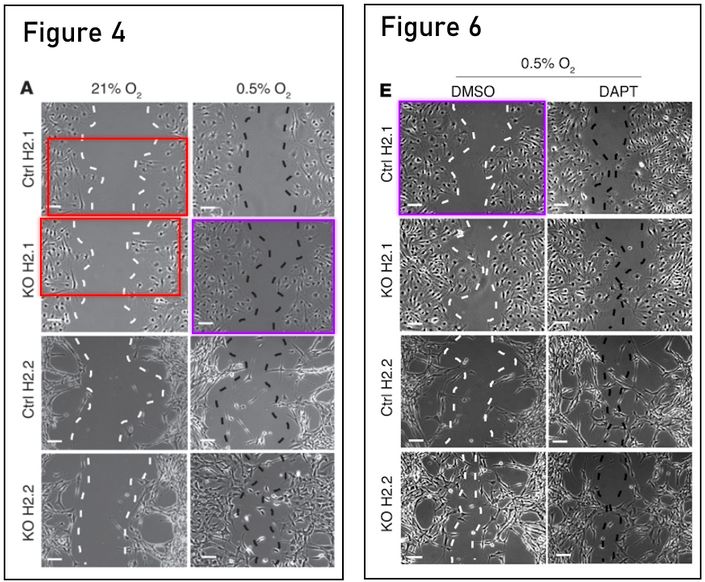
I subsequently received this response to my (admittedly antagonistic) emails:
“I have been advised not to engage with you further. I do appreciate your drawing attention to the error in the Nature Communications paper which we will formally correct.
However, you will not be hearing from me again.“
Celeste Simon
It is very gracious of Simon to agree to remedy just one of the sixteen documented errors but I am being sidetracked…
No response so far from Sam S. Yoon, Changhwan Yoon, or Sandra Ryeom who are the main characters of this story. How can they respond? Either they knowingly participated in the “illustration” of their own papers with what have become essentially stock photos, or they unwittingly signed as “authors” on research they could hardly have bothered to read, let alone write!
What Elsa Flores and Tyler Jacks taught each other
“PCR reactions run on agarose gels commonly look similar due to artifacts introduced by the agarose gel and comb.” Dr Elsa R Flores, Associate Director, Moffitt Cancer Center
The impressive list of distinguished researchers and institutions involved here (Memorial Sloan Kettering, Harvard Medical School, UCSF, Duke University, Mount Sinai Health System, etc etc) makes me wonder how exactly “research” is being conducted and authorship assigned. From my perspective it just looks like a lot of people endeavoured to dip their snout into a trough of citations! Why do successful and apparently intelligent surgeons feel the need to play pretend at biology research? Has Sam S. Yoon ever performed an invasion or migration assay? How many of the people who signed as his co-authors really understand the experiments being performed?
I’m always curious as to why some cases of misconduct go viral, and others are barely acknowledged. Francesca Gino generated a lot of media coverage (I suppose that is one of her skills) but she only meddled with some spreadsheets and taught a subject we know is mostly made up anyway. Sam S. Yoon is operating on people, training the next generation of surgeons, and surely being paid quite handsomely. No doubt somewhere along the way a bunch of mice really did get harmed, people’s tissue samples which were donated in good faith have been misused (OK, to be fair the cell lines are often just stolen, but the point remains that researchers should still use human research samples ethically). I expect (at best) several of his papers will eventually be retracted, essentially documenting the waste of (probably) millions in research funds, but such inconveniences will be taken in stride. I guess his defence will be that he was merely the supervisor of an errant researcher, but if this is how he “supervises” his research, does anyone trust his supervision of surgery?
Anil Sood and how much MD Anderson doesn’t care: whistleblowers speak out
“The graduate school at University of Texas MD Anderson does not care and keep sending students to his lab, Sood is a member of faculty there. RIO at MDACC doesn’t care because witnesses either left the country or are too afraid to speak.”
Please allow me to indulge myself in a postscript conspiracy theory: In 2021 a Molecular Therapy paper was withdrawn during the publication process, no further details are provided and there is no copy of the paper available online. The title of the paper was: “FOXC1 modulates stem-like cell properties and chemoresistance through hedgehog and EMT signaling in gastric adenocarcinoma”

The submission included many of the same suspects as authors (Soo-Jeong Cho, Hassan Ashktorab, Duane T. Smoot, Sandra W. Ryeom, Sam S. Yoon, Chang-ming Huang, and others). It seems fair to guess from the title that it would have included some of the same problematic duplications noted above, and (to my knowledge) these same migration and invasion images have not resurfaced since this withdrawal. Around the same time Sam and his team departed Memorial Sloan Kettering. So, perhaps the gang finally got caught out, stopped publishing these images, and quietly moved on. Of course, if I am correct, it looks like even more people are asleep at the wheel! How many of Sam’s coauthors and colleagues at Memorial Sloan, Molecular Therapy editors, and peer-reviewers already know about what’s happened here? It has now been two years since this withdrawal, with no corrections or retractions on Sam’s record. Of course, my conspiracy rests on the tenuous assumption that Molecular Therapy actually cares about publishing bogus research; there is ample evidence to the contrary…
Fraud Simple
US cancer research professors Paul B Fisher, Paul Dent and Stephen Grant look like the characters of a Joel and Ethan Coen crime movie, unfortunately never filmed. Smut Clyde will give you a peek into their spree of data manipulation
I thank all my donors for supporting my journalism. You can be one of them!
Make a one-time donation:
I thank all my donors for supporting my journalism. You can be one of them!
Make a monthly donation:
Choose an amount
Or enter a custom amount
Your contribution is appreciated.
Your contribution is appreciated.
DonateDonate monthly

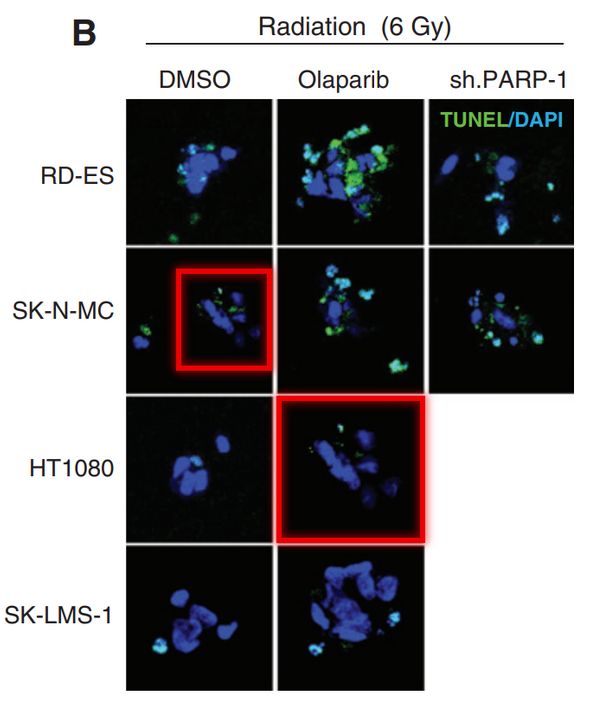
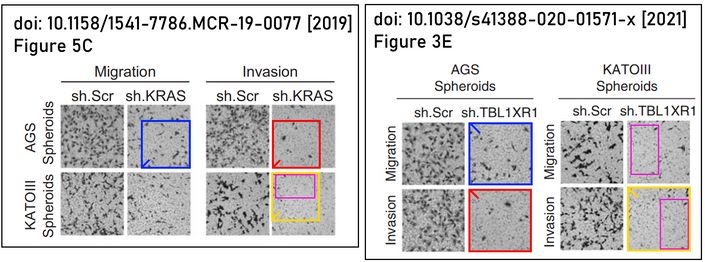

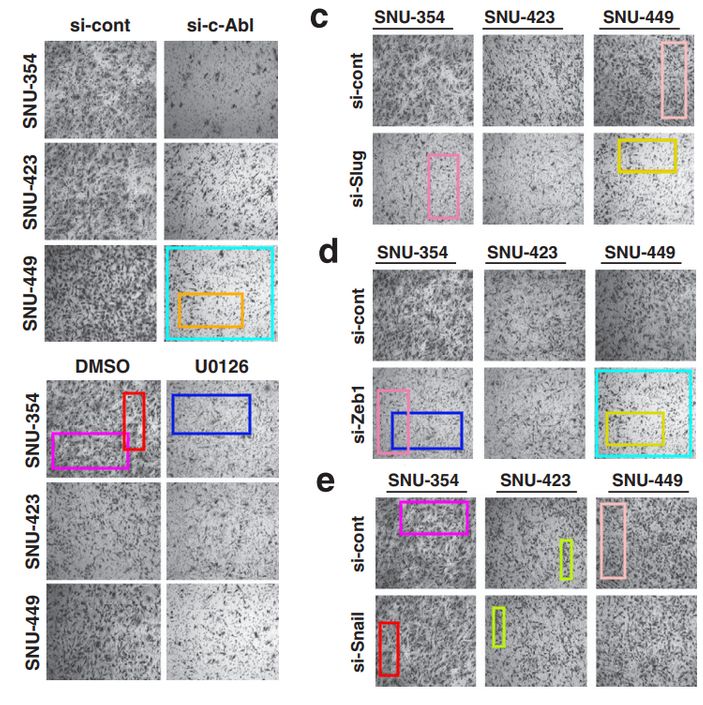

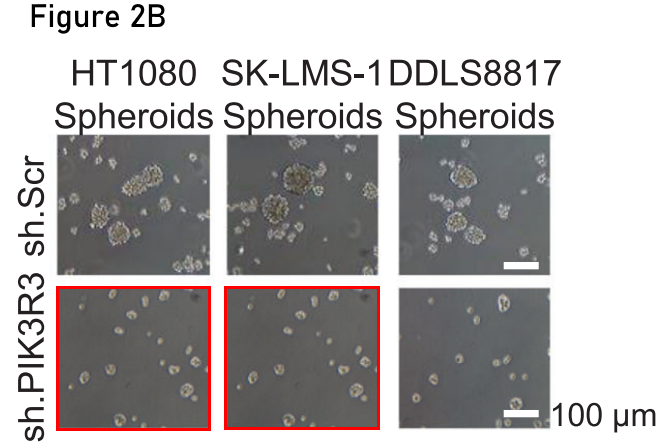
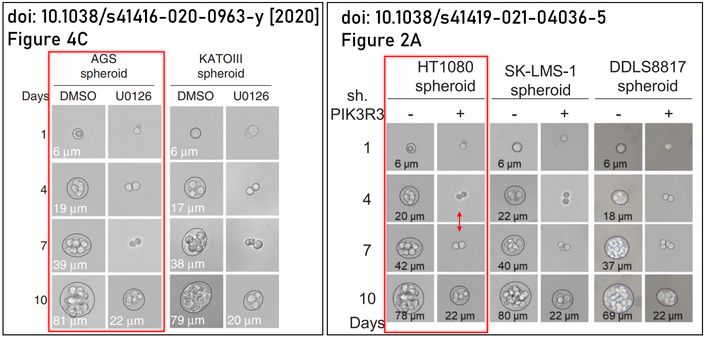
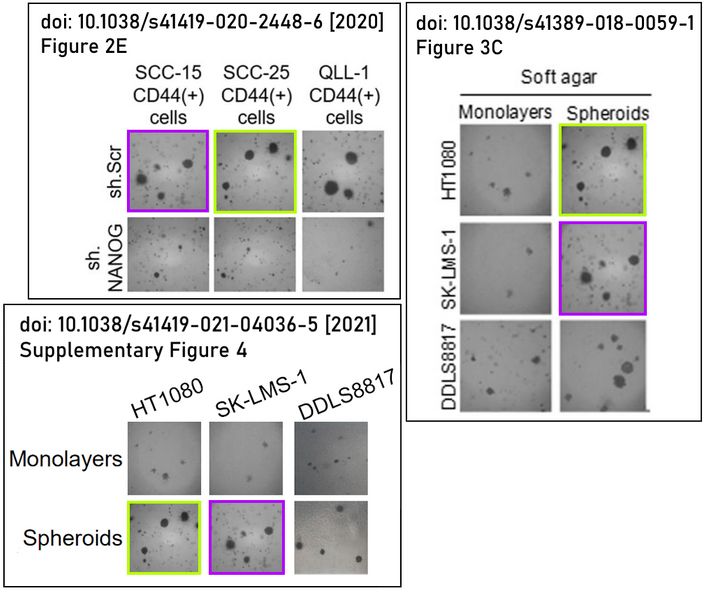
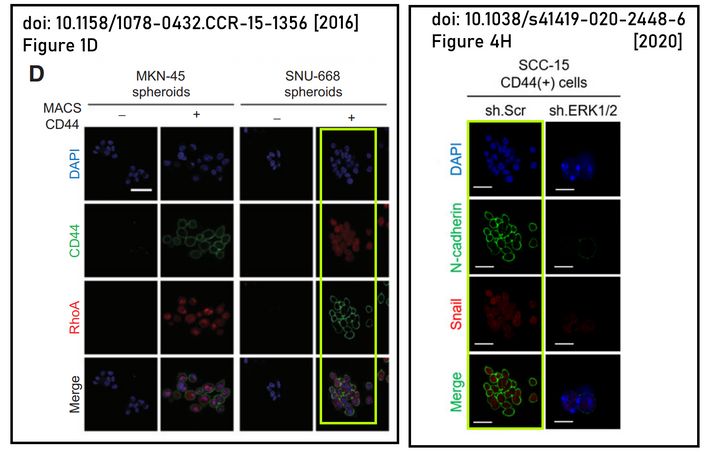

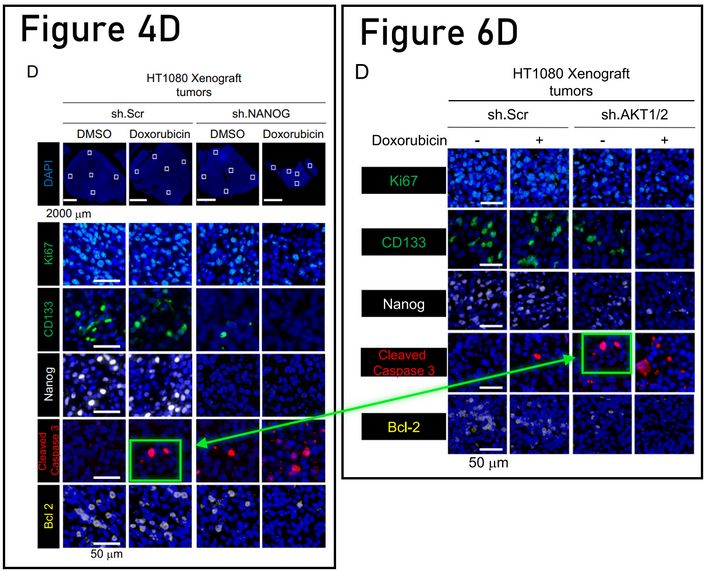
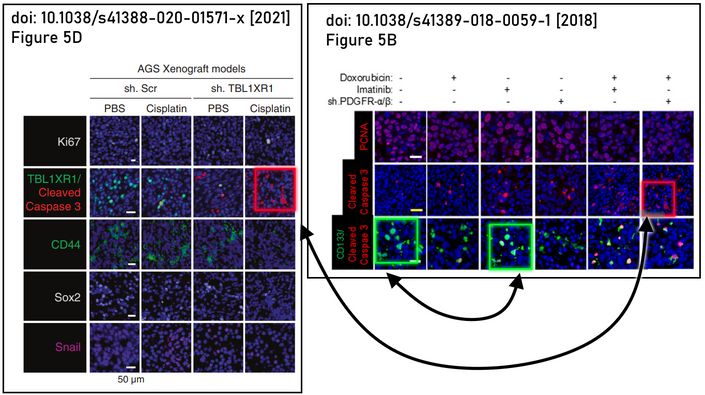
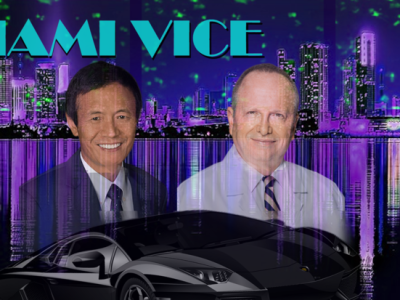
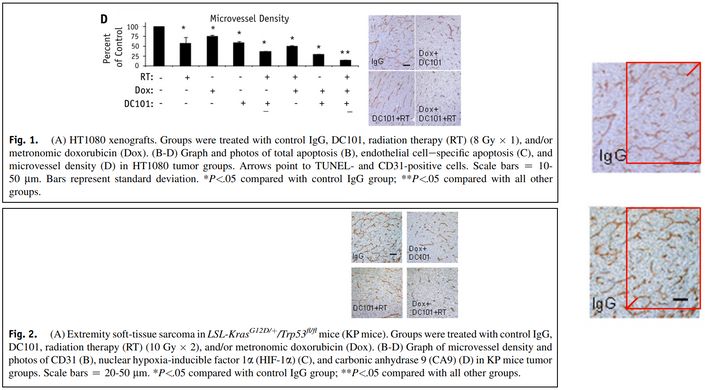
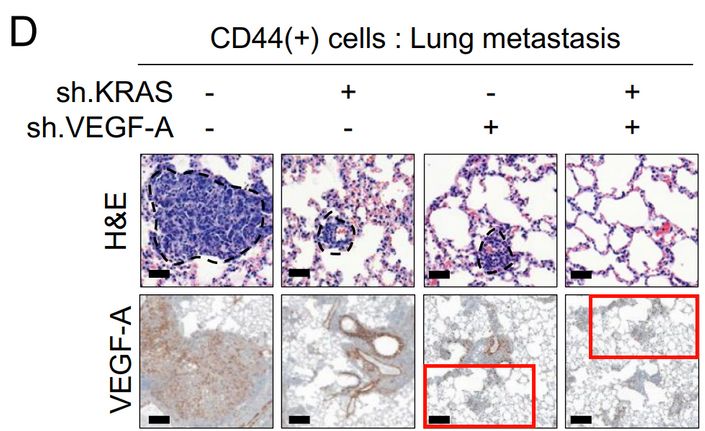
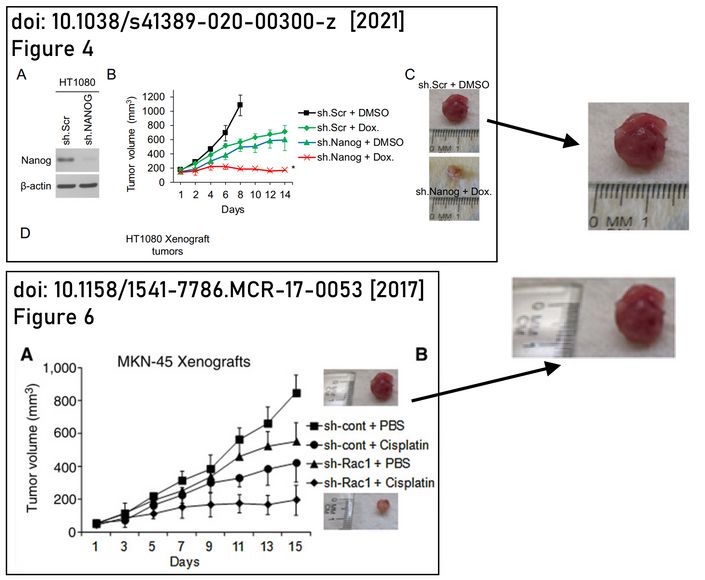
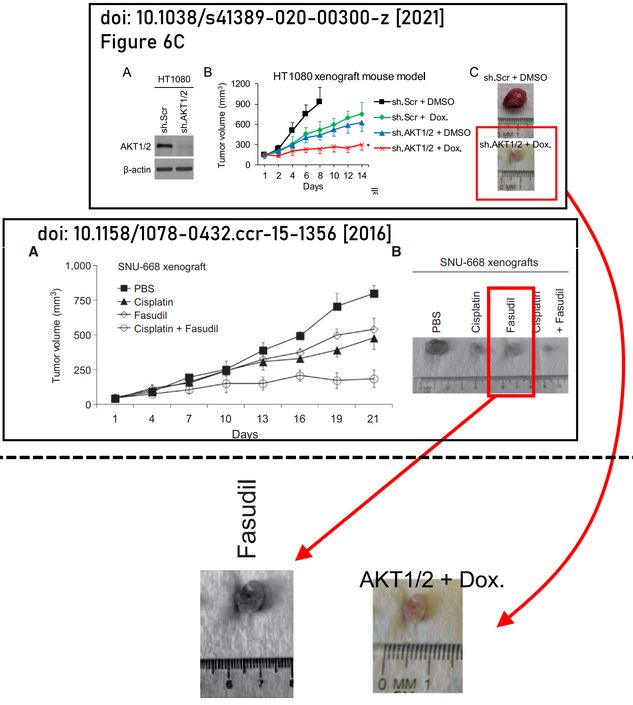
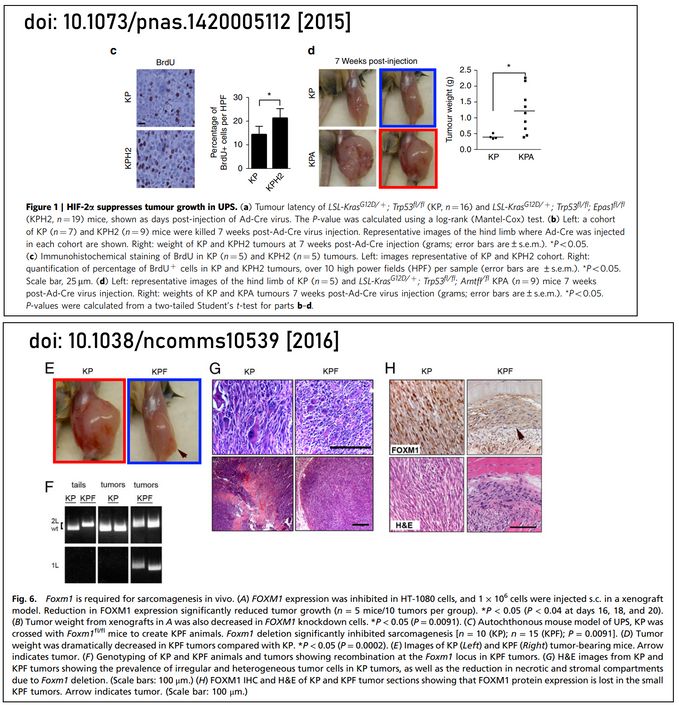





““I have been advised not to engage with you further. I do appreciate your drawing attention to the error in the Nature Communications paper which we will formally correct.
However, you will not be hearing from me again.“
Celeste Simon”
That means Celeste Simon, or the University of Pennsylvania, have got the lawyers out, and have received legal advice.
LikeLiked by 1 person
I would assume so, yes… I’ll forward her the blog post anyway, in case she wants to leave a comment…
LikeLiked by 1 person
Sam S Yoon is following in the footsteps of Sam(e) W Lee.
LikeLiked by 1 person
It is impressive that Sholto David can recognise the same cells/same tissue sections. Most of David Sholto’s analysis in the article depends on recognising the same cells/same tissue sections. I can do that rarely, mostly confined to comparing western blots. It makes me think that there are more faked images than commonly thought (about 2%).
LikeLiked by 1 person
Perhaps ImageTwin.ai should have been given more credit in the blog post, although I did mention it! I usually state where I have used it on PubPeer too. Most of the time it is a combination of both. I don’t think there are many things here that I wouldn’t have seen by eye, but the software certainly speeds up the process. I usually find western blots quite tedious to look at, so most of my posts on PubPeer are about cells, animals, and histology.
LikeLike
Great work. This article demonstrates (once more) research misconduct is massively present all around the United States of America, exactly like in any other country.
I recall that the Memorial Sloan Kettering Cancer Center is also house of James A. Fagin, a guy with an important PubPeer record:
https://pubpeer.com/search?q=fagin
LikeLiked by 1 person
Anyone seen authoring papers with Fusco is to be deemed as fraudster until credibly excused.
https://pubpeer.com/publications/6AC5BBE916149631A68A5134350FB1
LikeLike
“Starting back in 2008 when Sam [Yoon] was at Harvard Medical School, a fairly innocuous example of image duplication, which by itself, does not earn a blog post… although it is notable that seven employees of Harvard Medical School did not identify this error.”
Edward E Whang is a surgeon at Harvard, whose problematic data spans from 2003 until 2008. Perhaps Sam Yoon and Edward E Whang compared notes.
LikeLiked by 1 person
Now that Sam Yoon is at Columbia University he should compare notes with Wei Gu.
https://www.cancer.columbia.edu/profile/wei-gu-phd
Problematic data Wei Gu + Delin Chen
https://pubpeer.com/search?q=Wei+Gu+Delin+Chen
Wei Gu has more problematic data, but at Pubpeer entering Wei Gu alone into the search box and pressing return will pick up others due to the paucity of Chinese surnames.
LikeLiked by 1 person
“Edward E Whang is a surgeon at Harvard, whose problematic data spans from 2003 until 2008.”
I didn’t give Edward E Whang, Harvard, due credit.
He also has problematic data from 2012.
https://pubpeer.com/publications/686004DB5367318ABAA4E66092E1B1
LikeLike
“Why do successful and apparently intelligent surgeons feel the need to play pretend at biology research?”
Mark Duxbury, who has 5 retractions, and a Withdrawal from J Biol Chem, which uses withdrawal instead of retraction, therefore 6 retractions with Edward E Whang answers that question by his own website.
Under the section publications
https://www.markduxbury.info/publications
Mark Duxbury lists tens of publications, including a this one:
Duxbury MS, Ito H, Zinner MJ, Ashley SW, Whang EE. RNA interference targeting the M2 subunit of ribonucleotide reductase enhances pancreatic adenocarcinoma chemosensitivity to gemcitabine. Oncogene. [Comparative Study
Research Support, Non-U.S. Gov’t]. 2004 Feb 26;23(8):1539-48
but neglects to mention that it has been retractee.
https://pubpeer.com/publications/7A125D349C6B3403BA7B886D3FCC25
His own website is an advert for potential clients.
LikeLiked by 1 person
Another thing preventing any correction of the scientific record is the social. The higher-ups in the administration at Columbia University, and other institutions, will likely know the other higher-ups, will have wined and dined with them, cannot possibly believe that their results are made up.
The present President of Columbia University is an economist and long time manager, what would she know of the shenanigans in the biomedical “sciences”?
https://president.columbia.edu/
“President Minouche Shafik
Minouche Shafik became the 20th president of Columbia University on July 1, 2023. President Shafik is a distinguished economist who for more than three decades has served in senior leadership roles across a range of prominent international and academic institutions.”
LikeLiked by 1 person
Indeed! I’ll wait and see what happens in the next few months. Universities are even worse than journals and publishers in my experience, and the bar is not set high.
LikeLike
I agree with all of that. It is just part of the professional class game. Better not to have a conscience. Columbia University is science lite.
LikeLike
That’s a bit optimistic. The universities usually take several years, if ever, to clear up the problematic data. I know that there should be due process, but that should be timely. Harvard took 10 years to start to deal with the problematic Edward E Whang/Mark Duxbury data. That does seem far too long. 1 or 2 years, but not 10 years.
LikeLike
It is difficult to get a university to understand something, when its grant overhead depends on its not understanding it.
LikeLiked by 2 people
Something about New York City and the biomedical “sciences”, although to be fair Harvard is likely as bad.
LikeLiked by 1 person
Benjamin Neel does seem to have problematic data. Of course those do not have to be the reason for the suspension.
https://pubpeer.com/search?q=Benjamin+Neel
LikeLike
Is there a way out? We can expect statements from universities/scientific institutions where they profess adherence to the highest possible standards, yet at the same time they will want their own Johnnies to be number one Johnny and bring home the bacon.
LikeLike
Pointing out problematic data and expecting a helpful response from the authorities is similar to Martin Luther expecting a constructive response from bishop Albrecht Von Brandenburg.
“On 31 October 1517, Luther wrote to his bishop, Albrecht von Brandenburg, protesting against the sale of indulgences”
LikeLiked by 1 person
A funny analogy, thanks, I’ve been feeling a bit downhearted about my efforts here, but this made me laugh.
LikeLike
FYI: Cornell Med is in New York City.
Looks like 8 retractions to date for Augustine MK Choi.
http://retractiondatabase.org/RetractionSearch.aspx#?auth%3dChoi%252c%2bAugustine%2bM%2bK
Brought to you first by Leonid Schneider.
LikeLiked by 1 person
Martin Luther may not have been very nice, an anti-Semite of his time, but which was used much later on by the Nazis.
My point was more about the selling of indulgences being like being like journals and universities doing nothing about problematic data.
The Roman Catholic Church was, and is a business, just like the journals are businesses. They are all self-interested.
The journals and universities have lost sight of their true function of encouraging learning. They are in need of a reformation.
A slight aside. The Roman Catholic Church wrote to Copernicus several times asking him to publish his work about a sun-centred solar system. It was a business after all and wanted to know how things really worked.
It may have put Galileo under house arrest, but he did go out of his way piss it off.
It really did burn people to death so wasn’t that cuddly.
LikeLike
Run of the mill cancer fudge, tripe, which happens to be from Columbia University.
Nothing particularly dreadful, just run of the mill.
https://www.pathology.columbia.edu/profile/cory-abate-shen-phd
Problematic data, including first retraction (badge of honour).
https://pubpeer.com/search?q=Abate-shen
LikeLike
“[Sam Yoon] authored together with M. Luisa Iruela-Arispe (then at UCLA and now a department chair at Northwestern University Feinberg School of Medicine), and Daniel Karl (then at Harvard Medical School and now an associate director at AstraZeneca).”
And
“Soon after [Sam Yoon] his stint at Memorial Sloan Kettering started, the following figure was put together by Sam and his colleagues, including Jeffrey A Toretsky at Georgetown university (now Chief of the Division of Pediatric Hematology) and David Guy Kirsch at Duke University (now a Distinguished Professor there).”
Sam Yoon has built a coalition of quite high up people all with faked data cooking in the pot. The chances of anything being done about the faked data are remote. Sam Yoon has an army on his side.
LikeLike
“Sholto David broke all the rules. You see, when you write about research fraud, especially on a scale of a papermill, it is supposed to happen somewhere in Asia. Never in USA. Never in the most prestigious American universities and medical institutions.”
Doesn’t C Ronald Kahn, Harvard, count as a papermill all by himself?
https://nutrition.hms.harvard.edu/people/c-ronald-kahn
Problematic data+++
https://pubpeer.com/search?q=Ronald+Kahn+
LikeLike
You always get the impression that things don’t work properly in the U.S.. The “brown outs” that U.S. citizens don’t notice. Harvard with its Imperial Purple, or muddy red, and its awful record of fakes.
LikeLiked by 1 person
The U.S. is a sweatshop for postdocs. You do the work, but once your visa expires you have to leave. The PI will reap the benefit of your work.
Don’t go to the U.S.A. Stay in the European Union, or stay in Japan (a high quality county) if you are Japanese. Even better go to Canada rather than the U.S.A..
LikeLike
I remember some advice given by a consultant pathologist 30 years ago. At the time I thought the advice was slightly cruel. “Don’t go to the U.S.A. if you don’t have a job to come back to”. In retrospect I think he was correct. It is sometimes difficult to accept advice you don’t like.
If British people go to Australia, New Zealand, or Canada, the professional systems are compatible and qualifications are for the most part mutually recognised. Time there counts as time at home. When it comes to the U.S.A. it is ” out of the loop” as Americans say.
They might speak English, but the cultural links are tenuous, and beginning, middle and end, you are not a citizen.
Going to the U.S.A. is in fact a badge of failure.
LikeLiked by 1 person
I encourage all “aspirational immigrants” (I mean, immigrants who will create fraud to get ahead in american society), to think this way. To quote D. Trump: Stay in your sh*t hole. Yes.
LikeLike
C Ronald Kahn is a genius , one of America’s greatest minds. Ask Jeffrey Flier.
LikeLike
Based on what I’ve read, I think Jeffery Flier, in part, brown-noses Ronald Kahn because he thinks that it is his best chance to be with the dinner party with what he hopes and prays will be a nobel laureate: Ronald Kahn. This appears to be in the forefront of their minds:
https://www.sciencedirect.com/science/article/pii/S221287782100034X
American ego interfering with true progress (like D. Trump)? I think so.
LikeLike
Kahn’s Nobel is just as likely as my Pulitzer.
LikeLike
Sam S Yoon was a new one to me. The well of people making it up never seems to run dry.
Nearly all the major universities I can think of have had cases of people making it up.
LikeLiked by 1 person
The bit I don’t get is the way that universities will often not doing anything about problematic data more than a few years old, 3 years is the time limit many universities arbitrarily choose, the NIH chooses 6 years, yet the problematic data in the publications do not age, in fact older data have the advantage of “having stood the test of time”, and are thought to be more reliable by some. Many academics will have qualifications from before 3, or 6 years ago, but do not consider them unimportant, or throw them away.
It takes time for authors to build up a track record of problematic data. It takes even more time (after the event) for others to notice the track record of problematic data.
The data are either correct, or not. If the data on the page are problematic and the authors cannot find the original data that is a problem, nio a let out clause.
LikeLiked by 1 person
Cheating to get promotions and then doing “sensible” research seems like it was basically the career strategy of a lot of our “top researchers” today. When I look at papers from 2005, I have to laugh. They’ll have the grandest of titles and the sum total of the experimental “evidence” will be the most horribly spliced western blots, and maybe the odd black and white photo of a mouse or some cells… Wish I could have started my career then! Three years is a silly window 😂 When you’re looking for a job people consider your whole history, and papers can get more influential as they age.
Another point that aggravates me is that institutions want to blind themselves and refuse to investigate or even consider any research that wasn’t conducted at their institution. In the case of Francis Hornicek, he only recently moved to Miami, so they refused to investigate, but surely having someone so obviously corrupt and inept chairing a department should be a problem for them?! Apparently not!
LikeLike
“Cheating to get promotions and then doing “sensible” research seems like it was basically the career strategy of a lot of our “top researchers” today.”
Another explanation is that they did not later do “sensible” research, just that the journal guidelines became more explicit and they learned how to navigate the guidelines.
We can detect problematic data most often when they appear more than once. If the data do not appear more than once we will likely never know. Clever people can stick to the rule of only publish your data once, only the careless, or stupid, publish their data more than once. I suspect that the problematic data we can detect is skimming the surface. I don’t how deep it goes.
LikeLike
“Why do successful and apparently intelligent surgeons feel the need to play pretend at biology research?”
https://www.surgery.pitt.edu/people/timothy-r-billiar-md
Problematic data
https://pubpeer.com/search?q=timothy+billiar
I got bored.
LikeLike
“Why do successful and apparently intelligent [physicians] feel the need to play pretend at biology research?”
https://www.brown.edu/news/2021-04-08/elias
“Jack Elias to transition to senior health advisor at Brown, will leave role as medical school dean”
Transition is a lovely, and recent, American euphemism. I wonder why.
Problematic data anything to do with it?.
https://pubpeer.com/search?q=jack+a+elias
On the edge of something worse, Vineet Bhandari.
https://pubpeer.com/search?q=vineet+bhandari
Fraudster, Vineet Bhandari, duped by another fraudster.
https://pubpeer.com/search?q=dilip+shah
LikeLike
“Why do successful and apparently intelligent [physicians] feel the need to play pretend at biology research?”
https://pubpeer.com/publications/6BD341949D2731C1DEFADB1D01F1FF
uncovered Augustine M. Choi, a high-ranking physician, in charge of physicians even.
https://pubpeer.com/search?q=augustine+choi
LikeLike
“Why do successful and apparently intelligent [hematologist-oncologists] feel the need to play pretend at biology research?”
https://www.dfhcc.harvard.edu/insider/member-detail/member/kenneth-c-anderson-md/
https://pubpeer.com/search?q=kenneth+c+anderson
LikeLiked by 1 person
I have been turning up papers by Kenneth C Anderson recently, related to my search for Ruben D Carrasco, related to my search for Norman E Sharpless… I’m sure you know how these things cascade.
I can’t really tell if the “why do successful and apparently intelligent…” line is one you particularly like, or one I am being teased for writing. Anyway – a new blog post should be coming soon 😀
LikeLike
“I have been turning up papers by Kenneth C Anderson recently, related to my search for Ruben D Carrasco…”
Kenneth C Anderson, Harvard, has 3 retractions, 2 of the retractions are with Ruben D Carrasco.
http://retractiondatabase.org/RetractionSearch.aspx#?auth%3dAnderson%252c%2bKenneth%2bC
Kenneth C Anderson was editor-in-chief of Clin Cancer Research from 2007 until at least 2015.
https://www.aacr.org/professionals/membership/aacr-academy/fellows/kenneth-c-anderson-md/
“2007-Present {2015} Editor-in-Chief, Clinical Cancer Research
Kenneth C Anderson has a long, and growing at this moment, list of problematic data on Pubpeer.
https://pubpeer.com/search?q=kenneth+c+anderson
I used to send Kenneth C Anderson and the administration at Clin Cancer Research the data and also videos of Big Bird about which things are different and which things are the same. To no avail. Perhaps he is too old to have watched Sesame Street.
LikeLike
“why do successful and apparently intelligent…”
fits many “two jobs” physicians, who have problematic data.
LikeLike
“search for Norman E Sharpless”.
He was always there all the time. Couldn’t put my finger what pioneering work he’d done. Is he too good to be true?
One way to answer that question is to look at his data. Some data has been analysed at Pubpeer. Enter “Sharpless” into the Pubpeer search box and press the search icon, or press return!
LikeLike
What is Kettering? A know there is a town, but it may also be a noun.
I once saw a definition of Kettering as the marks left on your buttocks when you sit in a wickerwork chair for too long.
LikeLike
“Why do successful and apparently intelligent histopathologists feel the need to play pretend at biology research?”
https://www.foxchase.org/andres-klein-szanto
Problematic data
https://pubpeer.com/search?q=Klein-szanto
LikeLike
“Why do successful and apparently intelligent histopathologists feel the need to play pretend at biology research?”
https://profiles.mountsinai.org/carlos-cordon-cardo
https://pubpeer.com/search?q=Cordon-Cardo+
LikeLike
“But the trouble really started when a certain Changhwan Yoon migrated to Sam’s lab from South Korea in around 2014 (I don’t think he is any relation to Sam S. Yoon, but I may be mistaken).”
Without delay Changhwan Yoon, and Sam S. Yoon should be nominated for the “Korean Nobel Prize”.
Of note, Augustine “9 retractions” MK Choi is a previous winner of the Korean Nobel Prize.
https://news.harvard.edu/gazette/story/2011/04/korean-nobel-prize-goes-to-choi/
http://retractiondatabase.org/RetractionSearch.aspx?AspxAutoDetectCookieSupport=1#?AspxAutoDetectCookieSupport%3d1%26auth%3dChoi%252c%2bAugustine%2bM%2bK
LikeLike
FYI, Ryeom and Yoon are more than “closely associated.” They are married.
LikeLiked by 1 person
Can I ask how you know? I was actually really curious about that…
LikeLike
Your question is not directed at me but it is likely what MJ has written
In the US, privacy and data protection are not like in the European Union and the United Kingdom. The two of them share a current address and address history in addition to other data that makes it possible that they are partners. No marriage record found for her.
LikeLike
They are married. When Sam joined to Columbia as a chief, she also moved to the same department (as a package).
https://www.cuimc.columbia.edu/news/vp-s-welcomes-new-faculty-who-bring-wide-range-expertise
I “heard” the two labs share space, experiemnts and meetings. That’s why only one person is in the Sam’s lab (as Sandra is PhD, so can do 100% research).
LikeLike
I wonder why they aren’t just one lab then? Seems odd to run it as two separate labs.
LikeLike
two labs bring in twice as many grants than one!
LikeLike